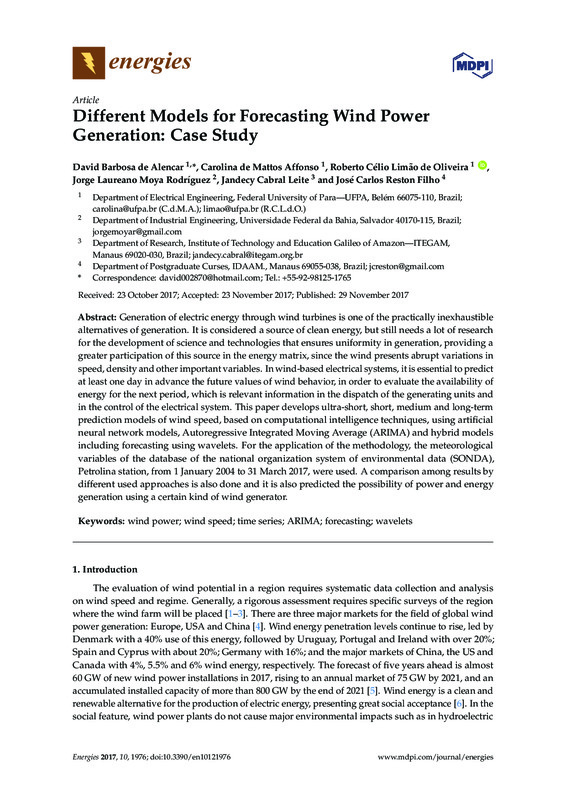Different Models for Forecasting Wind Power Generation: Case Study
Item
-
Tipo do ITEM
-
Artigo Ciêntifico
-
Título do Artigo
-
Different Models for Forecasting Wind Power Generation: Case Study
-
Descrição
-
Abstract: Generation of electric energy through wind turbines is one of the practically inexhaustible
alternatives of generation. It is considered a source of clean energy, but still needs a lot of research
for the development of science and technologies that ensures uniformity in generation, providing a
greater participation of this source in the energy matrix, since the wind presents abrupt variations in
speed, density and other important variables. In wind-based electrical systems, it is essential to predict
at least one day in advance the future values of wind behavior, in order to evaluate the availability of
energy for the next period, which is relevant information in the dispatch of the generating units and
in the control of the electrical system. This paper develops ultra-short, short, medium and long-term
prediction models of wind speed, based on computational intelligence techniques, using artificial
neural network models, Autoregressive Integrated Moving Average (ARIMA) and hybrid models
including forecasting using wavelets. For the application of the methodology, the meteorological
variables of the database of the national organization system of environmental data (SONDA),
Petrolina station, from 1 January 2004 to 31 March 2017, were used. A comparison among results by
different used approaches is also done and it is also predicted the possibility of power and energy
generation using a certain kind of wind generator.
Keywords: wind power; wind speed; time series; ARIMA; forecasting; wavelets
-
Abstract
-
Abstract: Generation of electric energy through wind turbines is one of the practically inexhaustible
alternatives of generation. It is considered a source of clean energy, but still needs a lot of research
for the development of science and technologies that ensures uniformity in generation, providing a
greater participation of this source in the energy matrix, since the wind presents abrupt variations in
speed, density and other important variables. In wind-based electrical systems, it is essential to predict
at least one day in advance the future values of wind behavior, in order to evaluate the availability of
energy for the next period, which is relevant information in the dispatch of the generating units and
in the control of the electrical system. This paper develops ultra-short, short, medium and long-term
prediction models of wind speed, based on computational intelligence techniques, using artificial
neural network models, Autoregressive Integrated Moving Average (ARIMA) and hybrid models
including forecasting using wavelets. For the application of the methodology, the meteorological
variables of the database of the national organization system of environmental data (SONDA),
Petrolina station, from 1 January 2004 to 31 March 2017, were used. A comparison among results by
different used approaches is also done and it is also predicted the possibility of power and energy
generation using a certain kind of wind generator.
Keywords: wind power; wind speed; time series; ARIMA; forecasting; wavelets
-
Língua do arquivo
-
inglês
-
Data da Publicação
-
Ano 2017
-
Palavra-chave
-
wind power
-
wind speed
-
time series
-
ARIMA
-
forecasting
-
wavelets
-
Autores
-
David Barbosa de Alenca
-
Carolina de Mattos Affonso
-
Roberto Célio Limão de Oliveira
-
Jorge Laureano Moya Rodríguez
-
Jandecy Cabral Leite
-
José Carlos Reston Filho
-
Local
-
ITEGAM - Manaus, 2017


